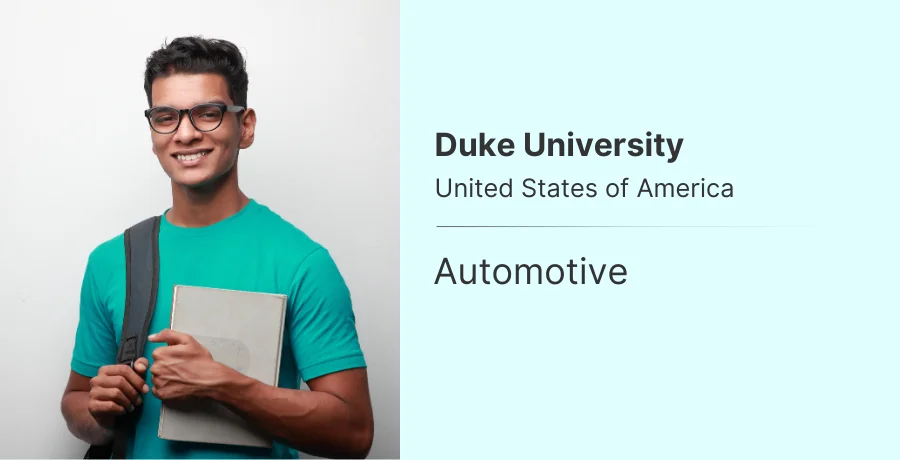Table of Contents
- Automotive at Stanford University USA – Highlights
- Why Study Automotive at Stanford University USA?
- Stanford University Automotive Rankings
- Stanford University Automotive Acceptance Rate
- Popular Automotive Courses at Stanford University USA
- Admission Requirements to Automotive at Stanford University USA
- Cost of Automotive at Stanford University USA for Indian Students
- Scholarships at Stanford University USA
- Job Prospects for Automotive at USA
- FAQs – Automotive at Stanford University USA
Automotive at Stanford University USA – Highlights
Stanford University, located in the heart of Silicon Valley, offers an exceptional Automotive Engineering course. This program is designed to provide students with a comprehensive understanding of automotive systems, advanced technologies, and the future of mobility. The course combines rigorous academic instruction with hands-on experience, preparing graduates to lead in the automotive industry.
The Automotive program at Stanford emphasizes innovation, sustainability, and interdisciplinary collaboration. Students have access to state-of-the-art facilities, and the opportunity to work on cutting-edge research projects. The program's close ties with industry leaders provide invaluable networking and career opportunities for students.
Why Study Automotive at Stanford University USA?
Stanford University is renowned for its commitment to academic excellence and innovation. The Automotive program is no exception, offering a curriculum that is both challenging and rewarding. Students benefit from the university's strong connections to the automotive industry and its emphasis on sustainability and technological advancement. Graduates are well-prepared to tackle the challenges of the modern automotive landscape.
- World-class faculty and resources
- Access to cutting-edge research and facilities
- Strong industry connections
- Focus on innovation and sustainability
Stanford University Automotive Rankings
| Ranking Body | Rank |
|---|---|
| US News and World Report | Top 10 |
| QS Ranking | Top 20 |
| THE Ranking | Top 15 |
| ARWU Ranking | Top 25 |
Stanford University Automotive Acceptance Rate
- The acceptance rate for the Automotive program at Stanford University is highly competitive.
- Only a small percentage of applicants are admitted each year, highlighting the program's exclusivity.
Popular Automotive Courses at Stanford University USA
- Bachelor's in Mechanical Engineering: This program offers a strong foundation in engineering principles with a focus on automotive systems and technologies.
- Bachelor's in Electrical Engineering: This course covers the electrical aspects of automotive engineering, including electric vehicles and advanced driver-assistance systems.
- Master's in Automotive Engineering: This advanced program delves deeper into automotive design, manufacturing, and innovation.
- Master's in Sustainable Mobility: Focuses on the development of sustainable transportation solutions and the future of mobility.
Admission Requirements to Automotive at Stanford University USA
Admission to the Automotive program at Stanford University is highly competitive. Applicants must demonstrate strong academic performance, relevant experience, and a passion for automotive engineering.
- Stanford University Automotive entrance exam
- Stanford University Automotive entry requirements
Eligibility criteria include a bachelor's degree in a related field for master's programs, and strong academic performance for undergraduate programs. Additionally, candidates should have relevant experience or a demonstrated interest in automotive engineering.
Applicants must also meet the university's general admission requirements, including proficiency in English and standardized test scores.
Documents Required
- Transcripts: Official academic records from previous institutions.
- Letters of Recommendation: Typically from academic or professional references.
- Statement of Purpose: An essay outlining the applicant's goals and motivations.
- Resume/CV: A detailed account of the applicant's academic and professional history.
Proficiency Test
Applicants must demonstrate proficiency in English through standardized tests such as TOEFL or IELTS. These tests assess the applicant's ability to succeed in an English-speaking academic environment.
Visa Process
- Obtain an I-20 form from Stanford University upon acceptance.
- Pay the SEVIS fee and complete the DS-160 form.
- Schedule and attend a visa interview at the US embassy or consulate.
- Provide necessary documents, including the I-20 form, passport, financial statements, and acceptance letter.
Cost of Automotive at Stanford University USA for Indian Students
Tuition Fees
The tuition fees for the Automotive program at Stanford University are approximately $50,000 per year. This amount covers the cost of academic instruction and access to university resources.
Cost of Living
The cost of living in the Bay Area can be high, with estimated expenses for housing, food, and transportation around $20,000 per year. However, students have access to a range of services and resources to help manage these costs.
| Expense | Cost (per year) |
|---|---|
| Tuition | $50,000 |
| Living Expenses | $20,000 |
| Total | $70,000 |
Scholarships at Stanford University USA
Stanford University offers a variety of scholarships to help students finance their education. These scholarships are awarded based on merit, need, or a combination of both.
- Stanford Graduate Fellowship: Provides full tuition and a living stipend for outstanding graduate students.
- Knight-Hennessy Scholars Program: Offers full funding for graduate studies across all disciplines at Stanford.
Job Prospects for Automotive in USA
Graduates of the Automotive program at Stanford University have excellent job prospects in the automotive industry. They are highly sought after by leading companies for their expertise and innovative approach.
| Job Title | Average Salary |
|---|---|
| Automotive Engineer | $80,000 - $120,000 |
| Design Engineer | $75,000 - $110,000 |
| Product Development Engineer | $85,000 - $130,000 |
FAQs – Automotive at Stanford University USA
- Can I work while studying Automotive at Stanford University? Yes, international students can work on-campus up to 20 hours per week during the academic year and full-time during breaks.
- What are the advantages of studying Automotive at Stanford University? Stanford offers world-class facilities, access to cutting-edge research, and strong industry connections, preparing students for leadership roles in the automotive industry.
- What is the average salary for graduates of the Automotive program? Graduates can expect an average salary ranging from $80,000 to $130,000, depending on their role and experience.
- What is the duration of the Automotive program at Stanford? The duration varies by program, with bachelor's degrees typically taking four years and master's degrees taking two years.
- What exams are required for admission to the Automotive program? Applicants may need to take standardized tests such as the GRE for graduate programs and meet English proficiency requirements through TOEFL or IELTS.
- What are the popular Automotive courses at Stanford University? Popular courses include Bachelor's in Mechanical Engineering, Bachelor's in Electrical Engineering, Master's in Automotive Engineering, and Master's in Sustainable Mobility.












